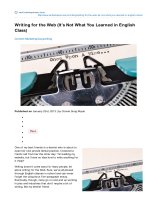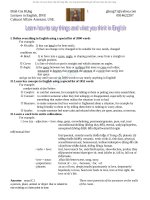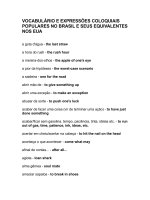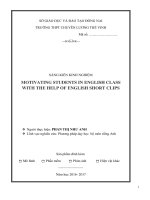Writing for the web its not what you learned in english class
Bạn đang xem bản rút gọn của tài liệu. Xem và tải ngay bản đầy đủ của tài liệu tại đây (170.64 KB, 3 trang )
vert icalresponse .co m
ticalrespo nse.com/blo g/writing-fo r-the-web-its-no t-what-you-learned-in-english-class/
Writing for the Web (It’s Not What You Learned in English
Class)
Content Marketing/Copywriting
Published on January 23rd, 2013 | by Connie Sung Moyle
One of my best f riends is a dentist who is about to
open her own private dental practice. I received a
f rantic call f rom her the other day: “I’m building my
website, but I have no idea how to write anything f or
it. Help!”
Writing doesn’t come easy f or many people, let
alone writing f or the Web. Sure, we’ve all plowed
through English classes in school and can never
f orget the ubiquitous f ive-paragraph essay.
Eventually, though, many go on and end up working
in jobs and industries that don’t require a lot of
writing, like my dentist f riend.
But now that almost everyone’s f irst destination f or
inf ormation is the Web, content – and being able to
produce it – is becoming more important, no matter
what your industry. And if you’re a small business,
having a website with inf ormative, engaging content
is crucial to marketing and growing your company.
If you’re in need of a little writing ref resher, here are
f ive website copywriting basics to know bef ore you start typing. (Hint: They’re probably not what your
English teacher taught you.)
1. Get to t he point , stat.
No need f or a f ormal intro paragraph here. If there’s one thing that the Web has conditioned all of us to
do well, it’s skimming content f or the interesting bits. If you’re trying to write your site’s “about” page, you
don’t need to start of f describing when and where you were born, unless it’s relevant to your business
or why you started it.
One exception to this rule is using that valuable f irst sentence or paragraph as a creative, catchy “hook,”
like a story or question. This can be a great tool to draw readers in, as long as it’s relevant to the rest of
the content on the page.
2. Embrace short paragraphs.
In school, we were taught that a paragraph had to have a minimum number of sentences. (Anyone
remember that magic number?) Not so in Web writing. A huge block of text is overwhelming f or readers,
especially on a website. Break it up into digestible paragraphs of around two to f ive sentences each.
3. A picture is worth a thousand words.
If something you’re trying to describe can be more easily understood with a photo, graphic or video, then
use the latter instead. T hat’s why inf ographics are so popular these days – people understand visuals a
lot quicker and easier than text.
I have another f riend who owns a premium denim business called Railcar Fine Goods. Instead of writing
about his special type of denim stitching, he posts tons of photos so readers can instantly see it
instead of trying to envision it in their heads. (He also hates writing, so this was an easy and ef f ective
way to get around it.)
4. Show some personality.
People want to do business with people, so keep that in mind when you’re writing f or the Web. Go ahead,
use “I” or “we” – you won’t get into trouble. One of the f irst things I recommended to my dentist f riend
was to avoid writing clinically or using words only dentists would understand. Be prof essional and error-
f ree, of course, but also have a little f un with your copywriting. A distinctive voice and perspective will
help dif f erentiate you f rom your competitors.
5. Consider SEO keywords.
This is unique to website copywriting. Sprinkling high-ranking terms and phrases in headlines and
throughout your website helps boost your position on a search results page when someone is searching
f or that term or phrase. Check out our post “12 Steps to Becoming a Natural at SEO” to learn how to get
the most SEO juice out of your content and copy.
Want more copywriting guidance? Check out all of our helpf ul copywriting/content marketing posts,
and/or visit Copyblogger.com, one of our f avorite writing resources here at VerticalResponse. It’s got
loads of tips on writing f or the Web, with new stuf f posted every day. The best part? T he writers
practice what they preach, so their articles are super-easy to read. Happy writing!
Tags: copywriting, how to write f or the web, online writing, search engine optimization, SEO, web writing,
website copywriting, website writing, writing, writing f or the web, writing tips
About the Author
Connie Sung Moyle is the Public Relations Manager at VerticalResponse.









